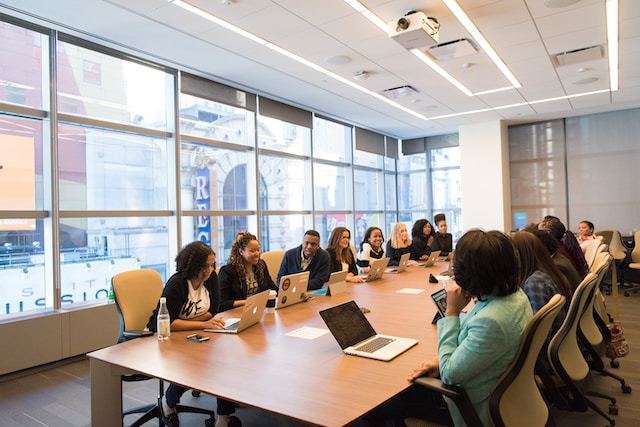Mentorship is an important part of any leadership development program. But should you formalize something that is often most powerful in its informal state? Having participated in and supported many different styles of mentorship program over the course of my career I believe the answer is often ‘yes,’ but beware that as often as mentorship programs are helpful, creating stronger leaders, stronger corporate culture and greater employee engagement, they can just as easily be a waste of an organization’s time and resources.
Photo by Christina @ wocintechchat.com
Understanding Mentorship Programs
Mentorship programs, such as corporate mentoring programs and formal mentoring programs within professional associations, are structured relationships within organizations that facilitate knowledge transfer and guidance between experienced and less experienced individuals. These programs offer invaluable opportunities for:
- Personal and professional development
- Fostering high retention and engagement rates
- Strengthening corporate cultures
- Enabling knowledge sharing between organizational leaders and less experienced employees
- Passing on industry experience and perspective
When designed and implemented effectively, both mentors and mentees often report that they are more productive thanks to their mentoring experience.
The Role of Mentors
Mentors play a crucial role in providing advice, support, and guidance to mentees (i.e., protégé), helping them reach their goals and maximize their potential. Pairing mentees with the right mentors is absolutely vital for a successful mentoring process. Mentors leverage their inspiring background, impressive skills, and invaluable expertise to improve the mentee’s experience in the workplace and industry. They share their knowledge and experiences, providing valuable guidance and advice to their mentees, who in turn can learn and grow from their mentor’s expertise.
When Mentors take their role seriously, they also act as positive role models, helping mentees navigate the challenges of the workplace, building strong careers and providing valuable insights into the organization’s or industry’s culture and professional networks. By fostering a strong mentoring relationship, mentors can empower their mentees to achieve their career goals and contribute positively to the organization’s success.
An often overlooked aspect of mentoring is the opportunity to help mentors become better leaders. Mentoring gives them opportunities to
- Practice their listening and coaching skills
- Learn more about parts of the organization they rarely spend time in
- Gain new perspectives on employee and customer insights
- Gain more experience leading with an inclusive focus
The Role of Mentees
Mentees are equally important in mentoring relationships, actively seeking guidance, feedback, and support from their mentors. They open themselves up to learning and growth opportunities, taking ownership of their own development. Mentees can reap the rewards of mentorship by acquiring knowledge and skills, expanding their professional network, and boosting their confidence.
To maximize their mentorship experience, mentees should embrace learning and growth opportunities, take ownership of their development, and actively participate in the mentorship relationship. This proactive approach is important to making the mentorship relationship success, but it is also an opportunity to practice leadership skills such as assertiveness and executive communication.
Mentoring gives mentees the opportunity to:
- Gain important insight into how to navigate corporate and industry culture
- Access experienced perspectives on their career potential and development
- Explore ideas and approaches to advancement they can’t receive from their supervisor
- Learn about leadership through personal role models
Types of Mentorship Programs
There are various types of mentorship programs, each with its unique structure and objectives. In this blog post, we will explore three main types: Traditional 1-on-1 Mentoring, Group Mentoring, and Reverse Mentoring.
Each of these program formats offers unique opportunities for growth and development, catering to different organizational needs and goals.
Traditional 1-on-1 Mentoring
Traditional 1-on-1 mentoring is an incredibly powerful tool for individual growth and development, fostering strong one-on-one relationships between a mentor and mentee. This type of mentorship program often pairs a more experienced or senior employee with a junior employee, providing them with personalized guidance and support to help them achieve their career goals and develop new skills.
One-to-one mentoring programs can:
- Empower junior employees by providing them with informal job training and a sense of ownership
- Help develop leadership skills
- Foster a strong sense of belonging within the organization or industry
- Lead to higher employee engagement and satisfaction
- Gain exposure to senior leadership
Group Mentoring
Group mentoring offers the opportunity to:
- Learn and grow together
- Collaboratively solve any issues that arise
- Foster a supportive environment and corporate culture
- Build strong internal networks
- Share experiences and learn from each other
In this type of mentoring program, one or more mentors guide a group of mentors. Mentors can be the same throughout the program, or can change so that over time the mentees gain exposure to a large number of senior leaders. Group mentoring can be particularly advantageous for organizations looking to launch a mentoring program without investing too much time and energy in managing a large number of individual relationships.
Group mentoring can provide mentees with an opportunity to:
- Engage in meaningful conversations and activities with a mentor
- Center discussions around a specific topic that is beneficial to them
- Create a sense of belonging and camaraderie among the group members
- Foster a more engaged and productive workforce.
Reverse Mentoring
Reverse mentoring is an effective way to facilitate knowledge transfer between generations. In this type of mentoring, a less experienced individual mentors a more experienced individual, often to gain fresh perspectives or learn about new technologies. This innovative approach to mentoring can provide unique insights and perspectives, helping the more experienced individual stay current with emerging trends and technologies, while empowering the less experienced mentor to contribute their ideas and expertise to the organization.
Some inspiring examples of reverse mentoring include an older employee being paired with a younger hire to gain insight into social media marketing or a senior executive being paired with an entry-level employee to gain a better understanding of the company’s day-to-day operations. Reverse mentoring offers a unique opportunity for both mentors and mentees to learn from each other and grow within the organization.
Implementing a Mentorship Program
Creating a successful mentorship program involves setting clear goals, selecting the right participants, and establishing a matching process. To many program leaders’ surprise it also involves a fair amount of followup with participants throughout the duration of the program.
Setting Program Goals
Clearly defining the purpose of a mentorship program is essential to ensure its success and maximize its impact. Setting achievable and measurable goals for the program helps guide its direction and provides a clear benchmark for evaluating its effectiveness over time. These goals should be documented and shared with all program participants, ensuring that everyone is in the program for the right reasons. For example, many mentees hope a mentor will help them get a new job, but most mentors and mentorship program leaders do not include job hunting in their program goals. It’s important everyone understands what the program hopes to achieve, and what it doesn’t.
To measure the success of the program, it’s important to establish key performance indicators (KPIs) that align with the program’s objectives. These KPIs can help track progress and ensure that the program remains relevant and beneficial for all participants. Regular checkpoints can be set up to monitor achievements and successes, while also providing support and resources to mentors and mentees throughout the mentorship journey.
Selecting Mentors and Mentees
Selecting the right mentors and mentors is crucial for creating productive and beneficial relationships within the mentorship program. When selecting participants, it’s essential to consider specific criteria that align with the objectives of the mentorship program, such as:
- Demonstrated enthusiasm
- Specific technical skills
- Leadership or communication skills
- Shared professional outlook
- Commitment to offer their time
In addition to selecting the right participants, it’s also important to create an atmosphere of enthusiasm and excitement around the mentorship program. Some strategies to consider include:
- Hosting launch, networking and closing events to introduce the program and engage ongoing interest
- Providing informational materials that highlight the benefits of mentorship and how to participate in the program and how to contact program leaders and other participants
- Encouraging potential mentors and mentees to participate through targeted outreach and communication
By implementing these strategies, you can help ensure a successful and engaging mentorship program.
Matching Process
Establishing a matching process is an essential step in implementing a successful mentorship program. A well-designed matching process ensures that mentors and mentees are paired effectively, leading to successful mentorship relationships that align with the program’s goals and objectives. There are two main types of matching available in a mentorship program: self-matching and admin-matching.
To ensure successful mentor matching, it’s important to consider how you want to match people or if you want them to match themselves. Creating comprehensive profiles for all participants, including their skills, interests, and goals, can help facilitate the matching process.
Here are the primary pros and cons of each mentor/mentee matching approach:
- Self-matching:
- PROS: greater participant satisfaction, somewhat less admin burden
- CONS: greater opportunity for participant bias to inform choices
- Admin-matching:
- PROS: more consistency in program participation
- CONS: greater admin burden
Regardless of the approach you use it’s important to have all participants include their goals for the program, and highlighted career achievements, in their applications to facilitate matching.
Followup and Check Ins
Many program leaders are surprised to learn how many participants, both mentors and mentees, can become distracted from their participation in the program, leading people to stop meeting and communicating. In addition, many participants will come across problems engaging their partners and need a program leader to intervene.
In addition to schedule regular events throughout the duration of the program, it’s important for program leaders to engage in proactive outreach to both mentors and mentees. This is a good opportunity to encourage their ongoing participation in the program and also to do informal pulse checks on how well program communication and support is performing.
Measuring the Success of Mentorship Programs
Tracking key performance indicators (KPIs) and gathering feedback are essential for evaluating the success of a mentorship program. In this section, we will discuss the importance of measuring the success of mentorship programs and the tools and methods that can be used to do so.
Measuring the success of a mentorship program is important to ensure that the program is achieving its goals.
Tracking Key Performance Indicators (KPIs)
KPIs can be a great tool to assess the effectiveness of a mentorship program and ensure it is meeting organizational objectives. However, tracking progress consistently can be challenging, as employees may be motivated to protect their goals and privacy. Some specific KPIs for mentorship programs may include:
- Match rate
- Participant growth
- Program health and sentiment
- Engagement metrics
- Progress metrics
- Participant engagement
- Participant satisfaction
- Employee/Member Retention rates
- Employee/Member Promotion rates
- Employee/Member Performance ratings
- Supervisor input and observations
By monitoring KPIs like these, organizations can gain valuable insights into the effectiveness of their mentorship program and make data-driven decisions to improve and optimize the program. Regularly reviewing KPIs and adjusting the program as needed can help ensure its continued success and alignment with organizational goals.
Gathering Feedback
Regular feedback, fathered formally and informally, from mentors and mentees is essential for identifying areas for improvement and optimizing the mentorship program. Feedback can help pinpoint areas for improvement, gauge the effectiveness of the program, and offer guidance on how to maximize the program’s success.
Organizations can gather formal feedback through various methods, such as:
- Surveys
- Interviews
- Focus groups
By analyzing the feedback and making necessary adjustments, organizations can continuously improve their mentorship program, ensuring its ongoing success and maximizing the benefits for all participants.
The Benefits of Mentorship Programs
Mentorship programs offer numerous benefits, including personal and professional growth, improved employee retention and engagement, and promoting diversity and inclusion within organizations through employee resource groups.
Personal and Professional Growth
Personal and professional growth are essential for developing new skills, increasing knowledge, and enhancing overall performance in your personal and professional lives. Mentorship programs create a great opportunity for mentors and mentees to share their expertise, knowledge, and skills, leading to meaningful personal and professional growth for both parties.
By participating in a mentorship program, individuals can acquire new skills, expand their professional network, and boost their confidence. This growth can lead to accelerated and more sustainable growth, improved work and relationship outcomes, and a more fulfilling, joyous, and higher quality of life.
Employee Retention and Engagement
Mentorship programs can improve employee retention and engagement by fostering a supportive and collaborative work environment. Research has shown that employees who participate in mentorship programs are more likely to feel satisfied with their jobs, with 9 out of 10 workers with a mentor reporting feeling satisfied and more than half rating themselves as “very satisfied”.
By providing opportunities for personal and professional growth, mentorship programs can help employees feel more engaged and committed to their organization’s success. This increased engagement can result in higher job satisfaction, lower turnover rates, and a more productive and dedicated workforce.
Promoting Diversity and Inclusion
Mentorship programs can help promote diversity and inclusion within organizations by:
- Connecting individuals from different backgrounds and experiences
- Fostering a welcoming environment that enables employees to express themselves fully
- Contributing to a more diverse and inclusive workplace culture
In addition to promoting diversity and inclusion, mentorship programs can also help underrepresented employees access resources and opportunities for career advancement. By providing support and guidance to employees from diverse backgrounds, mentorship programs can help break down barriers and create a more inclusive and equitable workplace for all.
To ensure a mentorship program achieves its goal of promoting diversity and inclusion it’s important for mentors to be prepared to work with mentees who have different life experiences than they do. Giving senior leaders essential awareness of their own unconscious bias can be an important way mentorship programs contribute to building a strong corporate culture in addition to growing the next generation of leaders.
Check out this complete listing of all InPower Coaching mentoring articles.
NOTE: This post was written with the help of an artificial intelligence research assistant. Comments? Please share.







